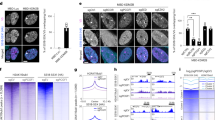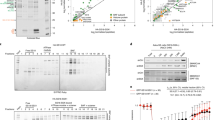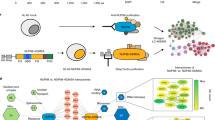Abstract
As a result of the synovial sarcoma-associated t(X;18) translocation, the SS18 gene on chromosome 18 is fused to either one of the three closely related SSX genes on the X chromosome. The SS18 protein is thought to act as a transcriptional co-activator, whereas the SSX proteins are thought to act as transcriptional corepressors. The main SSX-repression domain is located in its C terminus, a domain that is retained in the respective SS18–SSX fusion proteins. Both the SS18 and SSX proteins lack DNA-binding domains. Previously, we found that the SS18 and SS18–SSX fusion proteins may be tethered to DNA targets via the SS18-interacting protein AF10. Here, we set out to isolate proteins that interact with the SSX C-terminal repression domain using a yeast two-hybrid interaction trap. Of the positive clones isolated, two corresponded to the LIM homeobox protein LHX4, a DNA-binding protein that is involved in transcription regulation. An endogenous interaction was subsequently established in mammalian cells via colocalization and coimmunoprecipitation of the respective proteins. Interestingly, the LHX4 gene was previously found to be deregulated in various human leukemias. In addition, it was previously found that LIM homeobox proteins may bind to and activate the glycoprotein-α (CGA) promoter. Using LHX4 chromatin immunoprecipitation and CGA-promoter assays, we found that endogenous LHX4 binds to the CGA promoter and that LHX4-mediated CGA activation is enhanced by the SS18–SSX protein, but not by the SSX protein. Taken together, we conclude that this novel protein – protein interaction may have direct consequences for the (de)regulation of SSX and/or SS18–SSX target genes and, thus, for the development of human synovial sarcomas.
This is a preview of subscription content, access via your institution
Access options
Subscribe to this journal
Receive 50 print issues and online access
$259.00 per year
only $5.18 per issue
Buy this article
- Purchase on Springer Link
- Instant access to full article PDF
Prices may be subject to local taxes which are calculated during checkout





Similar content being viewed by others
References
Boyd KE, Wells J, Gutman J, Bartley SM, Farnham PJ . (1998). c-Myc target gene specificity is determined by a post-DNA binding mechanism. Proc Natl Acad Sci USA 95: 13887–13892.
Brett D, Whitehouse S, Antonson P, Shipley J, Cooper C, Goodwin G . (1997). The SYT protein involved in the t(X;18) synovial sarcoma translocation is a transcriptional activator localised in nuclear bodies. Hum Mol Genet 6: 1559–1564.
Clark J, Rocques PJ, Crew AJ, Gill S, Shipley J, Chan AM et al. (1994). Identification of novel genes, SYT and SSX, involved in the t(X;18)(p11.2;q11.2) translocation found in human synovial sarcoma. Nat Genet 7: 502–508.
Crew AJ, Clark J, Fisher C, Gill S, Grimer R, Chand A et al. (1995). Fusion of SYT to two genes, SSX1 and SSX2, encoding proteins with homology to the Kruppel-associated box in human synovial sarcoma. EMBO J 14: 2333–2340.
Cronwright G, Le Blanc K, Gotherstrom C, Darcy P, Ehnman M, Brodin B . (2005). Cancer/testis antigen expression in human mesenchymal stem cells: down-regulation of SSX impairs cell migration and matrix metalloproteinase 2 expression. Cancer Res 65: 2207–2215.
de Bruijn DR, Allander SV, van Dijk AH, Willemse MP, Thijssen J, van Groningen JJ et al. (2006). The synovial sarcoma-associated SS18-SSX2 fusion protein induces epigenetic gene (de)regulation. Cancer Res 66: 9474–9482.
de Bruijn DR, Baats E, Zechner U, de Leeuw B, Balemans M, Olde Weghuis D et al. (1996). Isolation and characterization of the mouse homolog of SYT, a gene implicated in the development of human synovial sarcomas. Oncogene 13: 643–648.
de Bruijn DR, dos Santos NR, Kater-Baats E, Thijssen J, van den Berk L, Stap J et al. (2002). The cancer-related protein SSX2 interacts with the human homologue of a Ras-like GTPase interactor, RAB3IP, and a novel nuclear protein, SSX2IP. Genes Chromosomes Cancer 34: 285–298.
de Bruijn DR, dos Santos NR, Thijssen J, Balemans M, Debernardi S, Linder B et al. (2001a). The synovial sarcoma associated protein SYT interacts with the acute leukemia associated protein AF10. Oncogene 20: 3281–3289.
de Bruijn DR, Kater-Baats E, Eleveld M, Merkx G, Geurts van Kessel A . (2001b). Mapping and characterization of the mouse and human SS18 genes, two human SS18-like genes and a mouse Ss18 pseudogene. Cytogenet Cell Genet 92: 310–319.
de Leeuw B, Balemans M, Geurts van Kessel A . (1996). A novel Kruppel-associated box containing the SSX gene (SSX3) on the human X chromosome is not implicated in t(X;18)-positive synovial sarcomas. Cytogenet Cell Genet 73: 179–183.
de Leeuw B, Balemans M, Olde Weghuis D, Geurts van Kessel A . (1995). Identification of two alternative fusion genes, SYT-SSX1 and SYT-SSX2, in t(X;18)(p11.2;q11.2)-positive synovial sarcomas. Hum Mol Genet 4: 1097–1099.
de Leeuw B, Suijkerbuijk RF, Olde Weghuis D, Meloni AM, Stenman G, Kindblom LG et al. (1994). Distinct Xp11.2 breakpoint regions in synovial sarcoma revealed by metaphase and interphase FISH: relationship to histologic subtypes. Cancer Genet Cytogenet 73: 89–94.
Debernardi S, Bassini A, Jones LK, Chaplin T, Linder B, de Bruijn DR et al. (2002). The MLL fusion partner AF10 binds GAS41, a protein that interacts with the human SWI/SNF complex. Blood 99: 275–281.
Dong WF, Heng HH, Lowsky R, Xu Y, DeCoteau JF, Shi XM et al. (1997). Cloning, expression, and chromosomal localization to 11p12–13 of a human LIM/HOMEOBOX gene, hLim-1. DNA Cell Biol 16: 671–678.
dos Santos NR, de Bruijn DR, Balemans M, Janssen B, Gartner F, Lopes JM et al. (1997). Nuclear localization of SYT, SSX and the synovial sarcoma-associated SYT-SSX fusion proteins. Hum Mol Genet 6: 1549–1558.
dos Santos NR, de Bruijn DR, Geurts van Kessel A . (2001). Molecular mechanisms underlying human synovial sarcoma development. Genes Chromosomes Cancer 30: 1–14.
dos Santos NR, de Bruijn DR, Kater-Baats E, Otte AP, Geurts van Kessel A . (2000a). Delineation of the protein domains responsible for SYT, SSX, and SYT-SSX nuclear localization. Exp Cell Res 256: 192–202.
dos Santos NR, Torensma R, de Vries TJ, Schreurs MW, de Bruijn DR, Kater-Baats E et al. (2000b). Heterogeneous expression of the SSX cancer/testis antigens in human melanoma lesions and cell lines. Cancer Res 60: 1654–1662.
Eid JE, Kung AL, Scully R, Livingston DM . (2000). p300 interacts with the nuclear proto-oncoprotein SYT as part of the active control of cell adhesion. Cell 102: 839–848.
Guillou L, Benhattar J, Bonichon F, Gallagher G, Terrier P, Stauffer E et al. (2004). Histologic grade, but not SYT-SSX fusion type, is an important prognostic factor in patients with synovial sarcoma: a multicenter, retrospective analysis. J Clin Oncol 22: 4040–4050.
Gure AO, Türeci O, Sahin U, Tsang S, Scanlan MJ, Jager E et al. (1997). SSX: a multigene family with several members transcribed in normal testis and human cancer. Int J Cancer 72: 965–971.
Gure AO, Wei IJ, Old LJ, Chen YT . (2002). The SSX gene family: characterization of 9 complete genes. Int J Cancer 101: 448–453.
Howard PW, Maurer RA . (2000). Identification of a conserved protein that interacts with specific LIM homeodomain transcription factors. J Biol Chem 275: 13336–13342.
Huntley S, Baggott DM, Hamilton AT, Tran-Gyamfi M, Yang S, Kim J et al. (2006). A comprehensive catalog of human KRAB-associated zinc finger genes: insights into the evolutionary history of a large family of transcriptional repressors. Genome Res 16: 669–677.
Ito T, Ouchida M, Ito S, Jitsumori Y, Morimoto Y, Ozaki T et al. (2004). SYT, a partner of SYT-SSX oncoprotein in synovial sarcomas, interacts with mSin3A, a component of histone deacetylase complex. Lab Invest 84: 1484–1490.
Kato H, Tjernberg A, Zhang W, Krutchinsky AN, An W, Takeuchi T et al. (2002). SYT associates with human SNF/SWI complexes and the C-terminal region of its fusion partner SSX1 targets histones. J Biol Chem 277: 5498–5505.
Kawai A, Naito N, Yoshida A, Morimoto Y, Ouchida M, Shimizu K et al. (2004). Establishment and characterization of a biphasic synovial sarcoma cell line, SYO-1. Cancer Lett 204: 105–113.
Kawai A, Woodruff J, Healey JH, Brennan MF, Antonescu CR, Ladanyi M . (1998). SYT-SSX gene fusion as a determinant of morphology and prognosis in synovial sarcoma. N Engl J Med 338: 153–160.
Kawamata N, Sakajiri S, Sugimoto KJ, Isobe Y, Kobayashi H, Oshimi K . (2002). A novel chromosomal translocation t(1;14)(q25;q32) in pre-B acute lymphoblastic leukemia involves the LIM homeodomain protein gene, Lhx4. Oncogene 21: 4983–4991.
Ladanyi M, Antonescu CR, Leung DH, Woodruff JM, Kawai A, Healey JH et al. (2002). Impact of SYT-SSX fusion type on the clinical behavior of synovial sarcoma: a multi-institutional retrospective study of 243 patients. Cancer Res 62: 135–140.
Lim FL, Soulez M, Koczan D, Thiesen HJ, Knight JC . (1998). A KRAB-related domain and a novel transcription repression domain in proteins encoded by SSX genes that are disrupted in human sarcomas. Oncogene 17: 2013–2018.
Liu Y, Fan M, Yu S, Zhou Y, Wang J, Yuan J et al. (2002). cDNA cloning, chromosomal localization and expression pattern analysis of human LIM-homeobox gene LHX4. Brain Res 928: 147–155.
Machinis K, Pantel J, Netchine I, Leger J, Camand OJ, Sobrier ML et al. (2001). Syndromic short stature in patients with a germline mutation in the LIM homeobox LHX4. Am J Hum Genet 69: 961–968.
Mischo A, Kubuschok B, Ertan K, Preuss KD, Romeike B, Regitz E et al. (2006). Prospective study on the expression of cancer testis genes and antibody responses in 100 consecutive patients with primary breast cancer. Int J Cancer 118: 696–703.
Nagai M, Tanaka S, Tsuda M, Endo S, Kato H, Sonobe H et al. (2001). Analysis of transforming activity of human synovial sarcoma-associated chimeric protein SYT-SSX1 bound to chromatin remodeling factor hBRM/hSNF2 alpha. Proc Natl Acad Sci USA 98: 3843–3848.
Naka N, Araki N, Nakanishi H, Itoh K, Mano M, Ishiguro S et al. (2002). Expression of SSX genes in human osteosarcomas. Int J Cancer 98: 640–642.
Perani M, Ingram CJ, Cooper CS, Garrett MD, Goodwin GH . (2003). Conserved SNH domain of the proto-oncoprotein SYT interacts with components of the human chromatin remodelling complexes, while the QPGY repeat domain forms homo-oligomers. Oncogene 22: 8156–8167.
Raetzman LT, Ward R, Camper SA . (2002). Lhx4 and Prop1 are required for cell survival and expansion of the pituitary primordia. Development 129: 4229–4239.
Richter K, Pinto do OP, Hagglund AC, Wahlin A, Carlsson L . (2003). Lhx2 expression in hematopoietic progenitor/stem cells in vivo causes a chronic myeloproliferative disorder and altered globin expression. Haematologica 88: 1336–1347.
Roberson MS, Schoderbek WE, Tremml G, Maurer RA . (1994). Activation of the glycoprotein hormone α-subunit promoter by a LIM-homeodomain transcription factor. Mol Cell Biol 14: 2985–2993.
Saito T, Nagai M, Ladanyi M . (2006). SYT-SSX1 and SYT-SSX2 interfere with repression of E-cadherin by snail and slug: a potential mechanism for aberrant mesenchymal to epithelial transition in human synovial sarcoma. Cancer Res 66: 6919–6927.
Schuettengruber B, Chourrout D, Vervoort M, Leblanc B, Cavalli G . (2007). Genome regulation by polycomb and trithorax proteins. Cell 128: 735–745.
Schwartz YB, Pirrotta V . (2007). Polycomb silencing mechanisms and the management of genomic programmes. Nat Rev Genet 8: 9–22.
Sharma K, Sheng HZ, Lettieri K, Li H, Karavanov A, Potter S et al. (1998). LIM homeodomain factors Lhx3 and Lhx4 assign subtype identities for motor neurons. Cell 95: 817–828.
Sheng HZ, Moriyama K, Yamashita T, Li H, Potter SS, Mahon KA et al. (1997). Multistep control of pituitary organogenesis. Science 278: 1809–1812.
Skytting B, Nilsson G, Brodin B, Xie Y, Lundeberg J, Uhlen M et al. (1999). A novel fusion gene, SYT-SSX4, in synovial sarcoma. J Natl Cancer Inst 91: 974–975.
Soulez M, Saurin AJ, Freemont PS, Knight JC . (1999). SSX and the synovial-sarcoma-specific chimaeric protein SYT-SSX co-localize with the human Polycomb group complex. Oncogene 18: 2739–2746.
Taylor BJ, Reiman T, Pittman JA, Keats JJ, de Bruijn DR, Mant MJ et al. (2005). SSX cancer testis antigens are expressed in most multiple myeloma patients: co-expression of SSX1, 2, 4, and 5 correlates with adverse prognosis and high frequencies of SSX-positive PCs. J Immunother 28: 564–575.
Thaete C, Brett D, Monaghan P, Whitehouse S, Rennie G, Rayner E et al. (1999). Functional domains of the SYT and SYT-SSX synovial sarcoma translocation proteins and co-localization with the SNF protein BRM in the nucleus. Hum Mol Genet 8: 585–591.
Türeci O, Chen YT, Sahin U, Gure AO, Zwick C, Villena C et al. (1998). Expression of SSX genes in human tumors. Int J Cancer 77: 19–23.
Türeci O, Sahin U, Schobert I, Koslowski M, Scmitt H, Schild HJ et al. (1996). The SSX-2 gene, which is involved in the t(X;18) translocation of synovial sarcomas, codes for the human tumor antigen HOM-MEL-40. Cancer Res 56: 4766–4772.
Vogel MJ, Guelen L, de Wit E, Peric-Hupkes D, Loden M, Talhout W et al. (2006). Human heterochromatin proteins form large domains containing KRAB-ZNF genes. Genome Res 16: 1493–1504.
Wu HK, Heng HH, Siderovski DP, Dong WF, Okuno Y, Shi XM et al. (1996). Identification of a human LIM-Hox gene, hLH-2, aberrantly expressed in chronic myelogenous leukaemia and located on 9q33–34.1. Oncogene 12: 1205–1212.
Wu HK, Minden MD . (1997). Transcriptional activation of human LIM-HOX gene, hLH-2, in chronic myelogenous leukemia is due to a cis-acting effect of Bcr-Abl. Biochem Biophys Res Commun 233: 806–812.
Yamaguchi M, Yamamoto K, Miura O . (2003). Aberrant expression of the LHX4 LIM-homeobox gene caused by t(1;14)(q25;q32) in chronic myelogenous leukemia in biphenotypic blast crisis. Genes Chromosomes Cancer 38: 269–273.
Acknowledgements
We thank Jack Fransen (Department of Cell Biology, Nijmegen Centre for Molecular Life Sciences) for assistance with the confocal laser scanning microscopy. This work was supported by a grant from the Dutch Cancer Society (KWF kankerbestrijding).
Author information
Authors and Affiliations
Corresponding author
Rights and permissions
About this article
Cite this article
de Bruijn, D., van Dijk, A., Willemse, M. et al. The C terminus of the synovial sarcoma-associated SSX proteins interacts with the LIM homeobox protein LHX4. Oncogene 27, 653–662 (2008). https://doi.org/10.1038/sj.onc.1210688
Received:
Revised:
Accepted:
Published:
Issue Date:
DOI: https://doi.org/10.1038/sj.onc.1210688
Keywords
This article is cited by
-
Synovial Sarcoma: A Complex Disease with Multifaceted Signaling and Epigenetic Landscapes
Current Oncology Reports (2020)
-
Synovial sarcoma is a gateway to the role of chromatin remodeling in cancer
Cancer and Metastasis Reviews (2015)
-
Genome-wide recruitment to Polycomb-modified chromatin and activity regulation of the synovial sarcoma oncogene SYT-SSX2
BMC Genomics (2012)
-
Identification of target genes for wild type and truncated HMGA2 in mesenchymal stem-like cells
BMC Cancer (2010)
-
Synovial Sarcoma: From Genetics to Genetic-based Animal Modeling
Clinical Orthopaedics and Related Research (2008)



